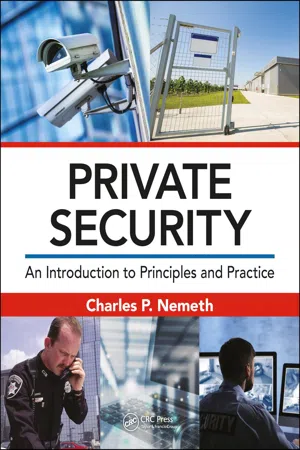
- 796 pages
- English
- ePUB (mobile friendly)
- Available on iOS & Android
About this book
There are few textbooks available that outline the foundation of security principles while reflecting the modern practices of private security as an industry. Private Security: An Introduction to Principles and Practice takes a new approach to the subject of private sector security that will be welcome addition to the field.
The book focuses on the recent history of the industry and the growing dynamic between private sector security and public safety and law enforcement. Coverage will include history and security theory, but emphasis is on current practice, reflecting the technology-driven, fast-paced, global security environment. Such topics covered include a history of the security industry, security law, risk management, physical security, Human Resources and personnel, investigations, institutional and industry-specific security, crisis and emergency planning, critical infrastructure protection, IT and computer security, and more.
Rather than being reduced to single chapter coverage, homeland security and terrorism concepts are referenced throughout the book, as appropriate. Currently, it vital that private security entities work with public sector authorities seamlessly—at the state and federal levels—to share information and understand emerging risks and threats. This modern era of security requires an ongoing, holistic focus on the impact and implications of global terror incidents; as such, the book's coverage of topics consciously takes this approach throughout.
Highlights include:
- Details the myriad changes in security principles, and the practice of private security, particularly since 9/11
- Focuses on both foundational theory but also examines current best practices—providing sample forms, documents, job descriptions, and functions—that security professionals must understand to perform and succeed
-
- Outlines the distinct, but growing, roles of private sector security companies versus the expansion of federal and state law enforcement security responsibilities
- Includes key terms, learning objectives, end of chapter questions, Web exercises, and numerous references—throughout the book—to enhance student learning
-
- Presents the full range of career options available for those looking entering the field of private security
-
- Includes nearly 400 full-color figures, illustrations, and photographs.
-
Private Security: An Introduction to Principles and Practice provides the most comprehensive, up-to-date coverage of modern security issues and practices on the market. Professors will appreciate the new, fresh approach, while students get the most "bang for their buck, " insofar as the real-world knowledge and tools needed to tackle their career in the ever-growing field of private industry security.
An instructor's manual with Exam questions, lesson plans, and chapter PowerPoint® slides are available upon qualified course adoption.
Frequently asked questions
- Essential is ideal for learners and professionals who enjoy exploring a wide range of subjects. Access the Essential Library with 800,000+ trusted titles and best-sellers across business, personal growth, and the humanities. Includes unlimited reading time and Standard Read Aloud voice.
- Complete: Perfect for advanced learners and researchers needing full, unrestricted access. Unlock 1.4M+ books across hundreds of subjects, including academic and specialized titles. The Complete Plan also includes advanced features like Premium Read Aloud and Research Assistant.
Please note we cannot support devices running on iOS 13 and Android 7 or earlier. Learn more about using the app.
Information
| Chapter 1 |
| Security origins and development |

Table of contents
- Cover
- Title Page
- Copyright Page
- Dedication
- Contents
- Preface: Introduction to Security
- Acknowledgments
- About the Author
- 1. Security origins and development
- 2. Concept, context, and definition: Security
- 3. Private security, public policing, and occupational roles
- 4. Private security industry, organizational structure, and definition
- 5. Private security and the law
- 6. Risk management
- 7. Physical security
- 8. Security: Human resources and personnel
- 9. Investigations and investigative reporting for the security professional
- 10. Crisis planning and prevention of accidents, emergencies, and disasters
- 11. Critical infrastructure security
- 12. Private security and art and cultural, educational, religious, and medical institutions
- 13. Private security: Hospitality, gaming, event, and mall property
- 14. Information, IT, and computer security
- 15. The future of the private security industry: A philosophical outlook
- Appendix A
- Appendix B
- Appendix C
- Appendix D
- Appendix E
- Appendix F: Physical security survey checklist
- Index